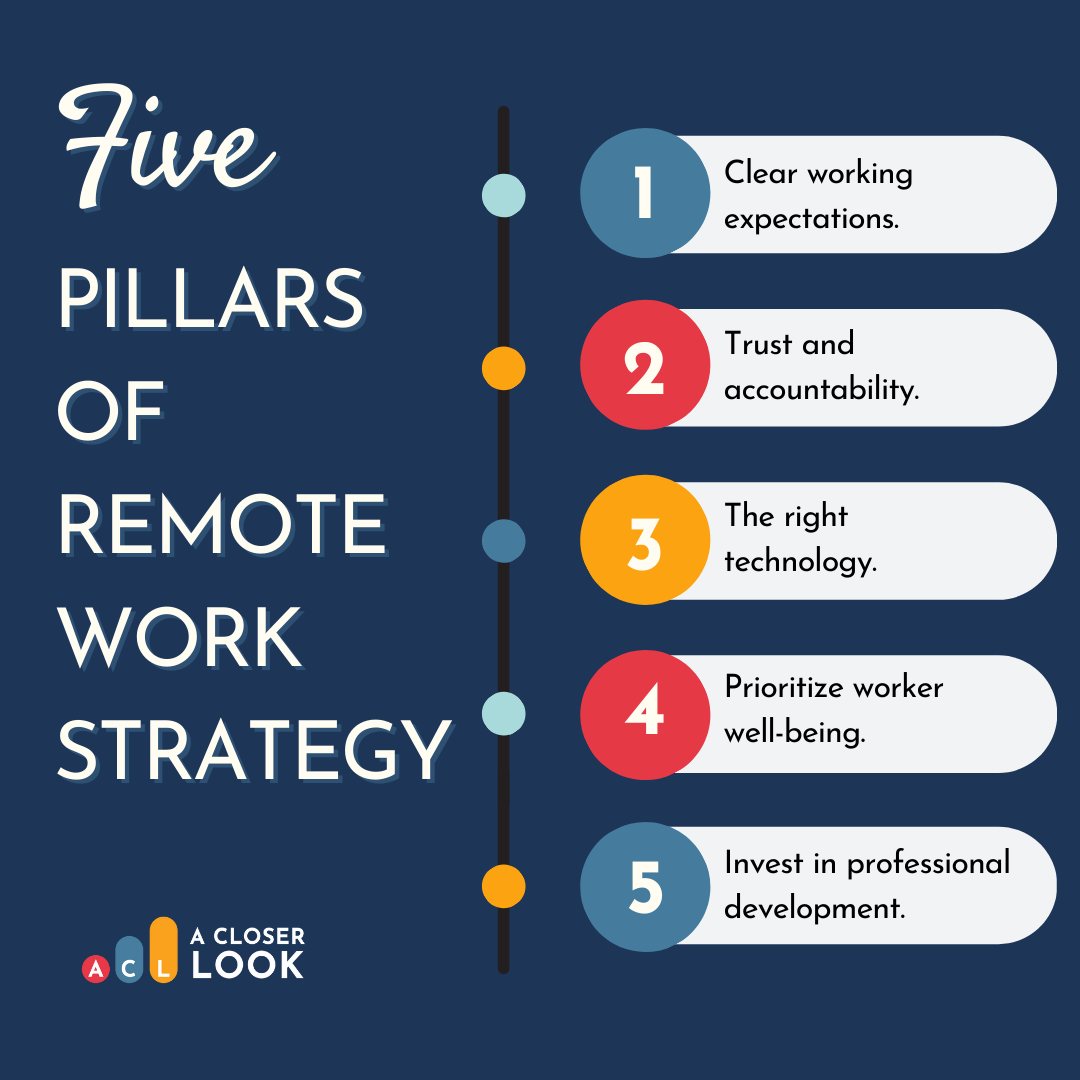
Remote Work Unleashed: The Five Pillars of an Effective Remote Work Strategy
Recently I had a chance to participate in a panel discussion at the CXOutsourcers mind share conference in Glasgow, Scotland to discuss the topic of recruitment and retention with some industry leading business process outsourcing (BPO) providers. Inevitably, the subject of remote work quickly emerged, and it was clear, it continues to remain a hotly contested subject for many companies.
Remote work has witnessed an exponential rise in popularity, fueled by advancements in technology, changing workforce demographics, and the global pandemic. According to a study by FlexJobs and Global Workplace Analytics, remote work was already on the rise prior to the pandemic. They found remote work grew by 159% from 2005 to 2017. The COVID-19 crisis simply acted as a force multiplier, forcing organizations to quickly switch their operations from in-office, to fully remote, almost overnight.
During the conference, Helen Beaumont Manahan, head of training and development at BPA Quality UK, introduced an intriguing concept she called “the magic weekend.” This term aptly describes the unrealistic expectation that someone can be promoted on a Friday and be fully prepared for their new role come Monday, without any substantial training or development. Similarly, this term resonates with the sudden shift in work culture that occurred when the pandemic hit. Overnight, employees went from working in the office to navigating remote work without proper planning or defined expectations. Companies were left with no choice but to hope that their workers would adapt and find a way to make it work.
1. Establish clear working expectations
2. Foster a culture of trust and accountability
During a recent conversation with a senior leader of a call center company, I inquired about his reservations regarding remote work. His response was rather telling: “I just worry that people will be too distracted and not give 100%.” However, it became clear that the issue at hand extended beyond remote work itself and delved into a more fundamental matter of trust. To cultivate a culture of trust, it is essential to adopt a mindset of positive intent. This means genuinely believing that the individuals you hire are committed to performing their best for the company. If there is already a preconceived notion that employees are inclined to slack off, trust will struggle to take root and flourish.
Being transparent about expectations and holding workers accountable for performance is paramount in building a best-in-class remote program.
3. Invest in the right technology
Having a well-defined technology plan is crucial for remote work success. It encompasses not only essential components like reliable connectivity, robust security measures, and adequate storage capacity, but also the right set of tools for seamless communication, efficient collaboration, and enhanced employee engagement. In a recent interview with Felix Serrano, Co-founder and CEO of Activus Connect, —an industry-leading provider of outsourced customer experience solutions employing over 2,700 remote agents across the United States—he emphasized the significance of a comprehensive remote work strategy, stating,
“Working remotely requires a technical environment that enables users to perform, to the best of their abilities. Much like a physical work-location that has the basics such as a workstation, badged access and restrooms so does it have methods for socialization, collaboration and team-based work, all of which are equally essential in a well-designed remote work environment.”
Fit-for-purpose remote environments have contemplated the user experience, not just at a basic technology level, but well beyond in the context of team-based-collaboration tools, socialization channels and even tech that encourages physical-fitness designed for the remote user.
4. Prioritize worker well-being
5. Invest in professional development
By shifting the focus to the outcome and excellence of their work, rather than fixating on the hours or effort invested, we empower both our employees and the company to move beyond outdated 8-to-5 working models.
There are a wide variety of performance engagement and management tools available on the market, however, our company elected to use a tool called Lattice to manage engagement and performance. With this tool, our teams can easily exchange feedback on a consistent basis, fostering a culture of continuous improvement and growth. This tool empowers teams to provide valuable insights, development advice, and guidance, allowing our workers to gain a deeper understanding of the internal growth opportunities available to them and the specific skills required to advance to the next level in their careers.
Development these days is no longer linear. Workers have more options than ever to learn skills outside of their core role. Cross training and upskilling workers are essential parts of a best-in-class remote strategy, as highlighted by Debbie Wilson, Managing Director of CCA Recruitment Group, a leading provider of recruitment solutions specializing in the call center industry.
“By providing opportunities for personal growth and development it demonstrates a business’s commitment to worker success. It allows the worker to feel a sense of job satisfaction in addition to the role they’re employed to do. This improves morale, loyalty, engagement and investing in the upskilling and cross training of people will significantly increase retention rates in remote work businesses.”
In conclusion, while remote work may not be a universally applicable approach, when implemented effectively, it can be a transformative game-changer. With the emergence of Artificial Intelligence, the proliferation of the gig economy, and the evolving perception of work, companies must carefully contemplate more flexible working arrangements. Whether opting for a fully remote setup, embracing a hybrid model, or adopting shorter work weeks, one thing remains evident: traditional work paradigms are undergoing disruption, and coercing individuals back into conventional office environments may prove counterproductive.